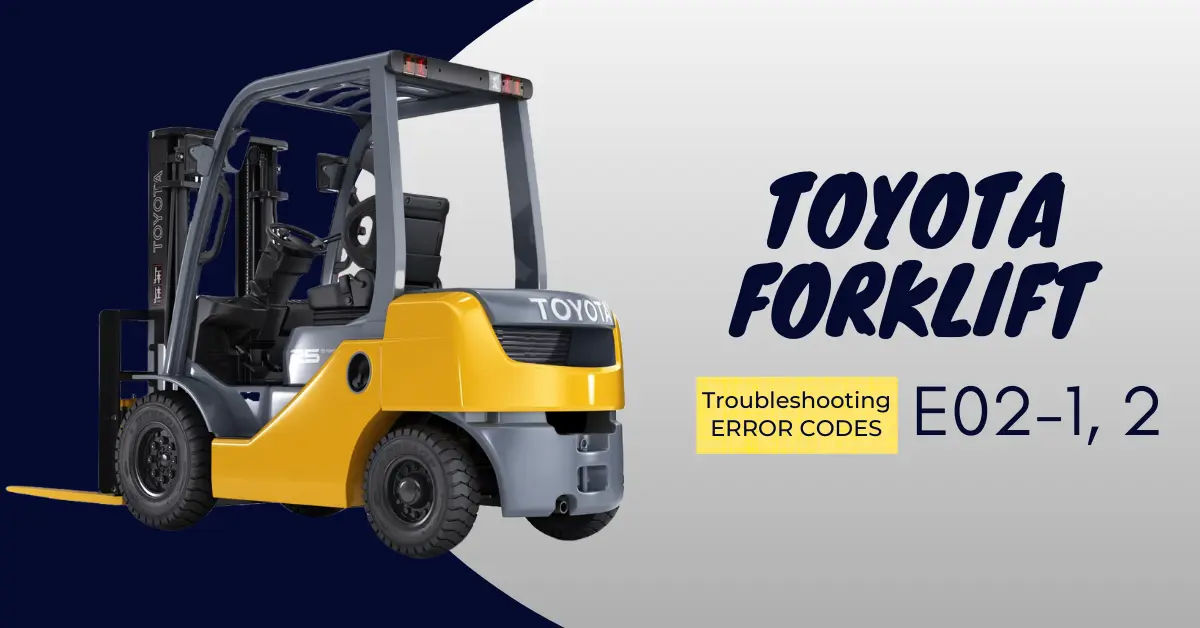Error codes E02-1 and E02-2 can disrupt Toyota forklift operations and lead to frustration. This post sheds light on these error codes and provides you with a practical approach to resolving them. Explore the resetting guide, troubleshooting tips, and essential knowledge to solve error codes 02-1 and 02-2 in the Toyota forklift.
Error Codes E02-1 and E02-2 on Toyota Forklift
Error codes 02-1 and 02-2 on a Toyota Forklift indicate an abnormality in the intake temperature sensor. In simpler terms, this means that there is an issue with the sensor responsible for measuring the temperature of the air going into the forklift’s engine.
When the intake temperature sensor malfunctions, it can have a noticeable impact on the Toyota forklift’s performance. The engine may experience difficulties in adjusting the air-to-fuel ratio, leading to suboptimal combustion and reduced power output. This can result in decreased acceleration, lower overall performance, and potentially even engine stalling or hesitation during operation.

Several factors can contribute to the occurrence of 02-1 and 02-2 error codes. The most common causes include a defective intake temperature sensor itself, a faulty wiring harness connecting the sensor, or a defect in the engine controller responsible for interpreting sensor signals. Identifying and addressing these underlying issues is essential for solving the E02-1 and E02-2 fault codes in the Toyota forklift.
Probable Causes
There are three main causes of the E02-1 and E02-2 error messages on the Toyota forklift.
- Intake temperature sensor defect
- Harness defect
- Engine controller defect
Resetting Guide
To reset error codes 02-1 and 02-2 on a Toyota forklift, follow these steps:
- Disconnect the battery negative terminal and wait for more than 10 seconds.
- Inspect and correct any disconnection or water entry issues in connectors C3 and AC2.
- Reconnect all connectors, ensuring they are securely attached.
- Reconnect the battery negative terminal.
- Turn the ignition key switch to the ON position and start the engine.
- Check whether the error codes have cleared.
If resetting successfully clears the error codes, it indicates a possible connector contact defect. To resolve this issue, thoroughly inspect the connectors, ensuring they are clean, free from corrosion, and making proper contact. Address any defects or connection issues, and then retest the forklift to ensure the error does not reappear.
However, if the error codes persist even after resetting, further troubleshooting is required. In such cases, it is recommended to inspect the intake temperature sensor and its harness for any defects, such as physical damage or loose connections. Additionally, check for short circuit continuity in the sensor and harness. Detailed instructions for troubleshooting these components can be found below.

Troubleshooting Guide
Resolving error codes 02-1 and 02-2 on a Toyota forklift requires a systematic inspection of the following components:
a). Intake Temperature Sensor Individual Inspection
The intake temperature sensor plays a crucial role in the forklift’s operation. It measures the temperature of the air being drawn into the engine, providing important data to the engine controller for optimizing fuel-air mixture and combustion. Incorrect readings from this sensor can trigger error codes and adversely affect the forklift’s performance.
To carry out the intake temperature sensor individual inspection, follow these steps:
1). Ensure the ignition key switch is in the OFF position.
2). Disconnect connector C3 and connect connector A35.
3). Using a multimeter, measure the resistance between terminals C3-1 and C3-2.
4). The readings should be approximately 2.45 ± 0.24 kilo-ohms at 20°C (room temperature) and 0.32 ± 0.03 kilo-ohms at 80°C (higher temperature).
| C3-1 ~ C3-2 | 2.45 ± 0.24 kΩ (20°C) |
| 0.32 ± 0.03 kΩ (80°C) |
5). By checking these resistance values, you can determine if the intake temperature sensor is functioning correctly. Any significant deviation from the specified readings may indicate a defect in the sensor, requiring further investigation and potential replacement.
b). Harness Continuity and Short Circuit Inspection
The harness connects various components, including the sensor, to the engine controller. Any issues with the harness can disrupt the flow of electrical signals and trigger error codes 02-1 and 02-2.
To conduct the harness continuity and short circuit inspection, follow these steps:
1). Ensure the ignition key switch is in the OFF position.
2). Disconnect connectors A35 and C3.
3). Measure the continuity between terminal A35-29 and C3-2. There should be continuity, indicating a proper connection.
4). Measure the continuity between terminal A35-28 and C3-1. There should also be continuity between these terminals.
5). Measure the continuity between terminal A35-29 and the frame of the forklift. There should be no continuity, indicating no direct connection to the frame.
| A35-29 ~ C3-2 | Continuity |
| A35-28 ~ C3-1 | Continuity |
| A35-29 ~ Frame | No continuity |
6). By performing these continuity tests, you can verify that the harness is properly connected and not experiencing any short circuits. If any continuity or short circuit issues are detected, further inspection and potential repairs or replacements may be necessary to rectify the problem.
Summary
Error codes E02-1 and E02-2 indicate an issue with the intake temperature sensor of the Toyota forklift. These fault codes can arise from a defective sensor, a faulty wiring harness, or a malfunctioning engine controller. If resetting doesn’t clear the error, the troubleshooting includes inspecting the intake temperature sensor and its harness for defects and checking for short circuits.
Without resolving these errors, the engine may experience difficulties in adjusting the air-to-fuel ratio, leading to inefficient combustion. This can result in reduced power output, decreased acceleration, and overall lower performance of the forklift. In some cases, the engine may even stall or hesitate during operation, hindering productivity in a warehouse or industrial setting.
